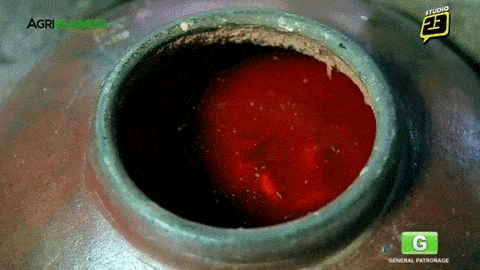bagoóng
A fermented fish or shrimp paste, often classified under two major categories - bagoong na isda (made with fish) or bagoong alamang (made with tiny sea or river shrimp).
In its simplest form, bagoong is a condiment composed of two ingredients - fresh fish or shrimp and pure sea salt, traditionally fermented in large clay pots called tapayan (or burnay) from anywhere between 30-90 days or longer.
Common varieties of fish used in bagoong na isda include dilis (sardines), bolinaw (anchovy), galunggong (round scad) and sapsap (small, flat ponyfish)
Among shrimp, a variety called krill (from the Norwegian meaning ‘young fry of fish’) are primarily used for bagoong alamang, though some inland provinces utilize freshwater river shrimp when in season.
To achieve the trademark redness of fresh (uncooked) bagoong, an ingredient called angkak (fermented red yeast rice) is added to the fish or shrimp.
As a cooking method often applied to alamang, bagoong guisado (sauteed/cooked bagoong) is prepared by sautéing garlic, onions and tomatoes (the Filipino trinity called gisa, a flavour base similar to soffrito) in rendered pork fat along with vinegar and a bit of sugar.
My attachment and desire for bagoong runs deep, deep as the waters from where traditional species of fish and river shrimp are harvested to create the wonderfully complex, pungent fermented paste beloved by so many Filipinos. Bagoong is a feature ingredient in dishes such as binagoongan (pork sautéed with bagoong) or pinakbet (vegetables stewed in bagoong) and steadfast in its place as a side to peanutty kare-kare (oxtail stew) and sour green mangoes.
Further resources
• A dissertation titled “Characterization of Salt-fermented Shrimp Paste from the Philippines” by Anna Rose Pilapil at Universiteit Gent in Belgium. A landmark paper in my opinion - from the abstract: “Shrimp paste or bagoong alamang is an important fermented commodity in the Philippines and in this research, it was comprehensively characterized. Pastes samples were procured in the Philippines and were brought to Belgium for biochemical analyses.” Provides an incredibly detailed overview on fermentation, and how fermented shrimp pastes are produced across Southeast Asia (including Malaysian belacan, Indonesian trasi, Burmese nga-pi and Thai kapi).
• Filmed in Taglish, a clip about the Bagoong Industry in the Philippines - of interest for visuals on how bagoong is commercially produced and packaged. That swirl.

• And also, a recipe for Honey Bagoong Chicken Wings - because!
Primary information translated from the wonderful community behind Sagisag Kultura. Additional research via papers cited above.
